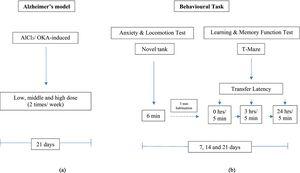
Introduction/objectives
Alzheimer’s disease (AD) is characterised by a progressive decline in cognitive abilities, especially learning and memory. To validate the zebrafish as a suitable model organism for AD, the study examined the effects of 2 neurotoxin agents, aluminium chloride (AlCl3) and okadaic acid (OKA). In the full experimental design, both neurotoxins were administered intraperitoneally at 3 distinct doses (low, medium, and high) twice weekly for 21 days. At 3 time-points, behavioural tasks were conducted on day 7 (short duration), day 14 (moderate duration), and day 21 (long duration). The behavioural tasks consisted of a novel tank test lasting 6 min, followed by a T-maze tank test lasting 5 min.
Methods
In this article, the T-maze tank test was discussed in detail to evaluate which neurotoxins and their optimal dosages are impactful in developing a zebrafish AD model towards learning and memory functions. This evaluation measured four parameters: the amount of time spent in the wrong arm, the total distance travelled in the deeper chamber, and the 3-h and 24-h inflexion ratios.
Results
In summary, a 100nM dosage of OKA with a maximum of 21 days of evaluation resulted in significant (P<.05) outcomes in all parameters evaluated. The longest duration was spent in the wrong arm, accompanied by a reduction in the total distance travelled in the deeper chamber and a decreasing pattern in the 3-h and 24-h inflexion ratios.
Conclusion
These observations suggest that OKA is the optimal choice of neurotoxin for a validated and optimised zebrafish AD model.



